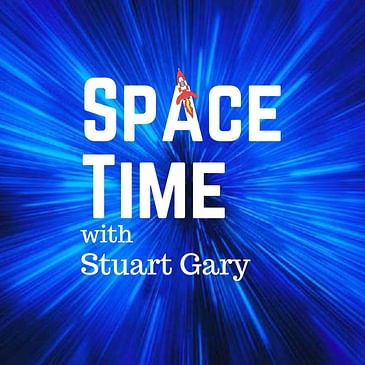🚀 We would love your feedback. How's SpaceTime travelling...love it or hate it, we need to hear it all. Take the 1-minute survey and let us know what you think: Click Here

SpaceTime with Stuart Gary
Astronomy, Space & Science News
Recognized worldwide by our listeners and industry experts as one of the best and most thoroughly researched programs on Astronomy, Space, and Science News.
Hosted by Stuart Gary, a veteran radio science reporter, broadcaster and now podcaster.
Keep up-to-date and learn something new with every episode.
New episodes weekly. Three new episodes are published on Mondays for our subscribers and individual episodes publicly on Monday, Wednesday, and Friday.
Show your support for SpaceTime, help us reach our goals with early access to commercial-free episodes and bonuses via Supercast, Patreon, Apple Podcasts and YouTube.
Links at https://spacetimewithstuartgary.com/about
Enjoy!
Become a supporter of this podcast: https://www.spreaker.com/podcast/spacetime-with-stuart-gary--2458531/support.
Reviews
S27E90: Black Hole Discovery in Omega Centauri, Juice's Lunar Flyby, and Space Suits Inspired by Dune
Join us for SpaceTime Series 27 Episode 90, where we delve into the latest cosmic events and advancements in space exploration. **Discovery of an Intermediate Mass Black Hole**: Astronomers have detected what they believe is a rare intermediate mass black hole buried deep inside the Omega Centauri g...
S27E89: Titan's Tiny Waves, Moon Caves for Astronauts, and Fire Risks in Space
Join us for SpaceTime Series 27 Episode 89, where we explore the latest cosmic events and advancements in space exploration. - Titan's Tiny Waves: Astronomers have determined that the seas of Saturn's largest moon, Titan, exhibit very tiny waves, only a few millimetres high. The findings, based on d...
S27E88: Earth's Wobble, The Three-Body Dilemma, and SpaceX's Setback
Join us for SpaceTime Series 27 Episode 88, where we delve into the latest cosmic events and advancements in space exploration. - ** Climate Change and Earth's Rotation **: Discover how human activity is altering the planet's rotation. New studies reveal that melting ice masses in Greenland and Anta...
S27E87: NASA's Speed Demon, China's Space Secrets, and Radio Vision of the Universe
Join us for SpaceTime Series 27 Episode 87, where we delve into the latest cosmic events and advancements in space exploration. **NASA's Parker Solar Probe**: NASA's Parker Solar Probe has just completed its 20th close approach to the Sun, setting a new record as the fastest man-made object ever bui...
S27E86: Neutron Star Mysteries, Red Sprites from Space, and Hurricane Beryl's Fury
Join us for SpaceTime Series 27 Episode 86, where we explore the latest cosmic events and advancements in space exploration. First, new sophisticated computer models are giving scientists a glimpse inside neutron stars, revealing that these exotic objects might be made of nuclear pasta. Discover how...
S27E85: Mars' Icy Past, Ariane 6's Debut, and Starliner Stuck in Space
Join us for SpaceTime Series 27 Episode 85, where we explore the latest cosmic events and advancements in space exploration. - First, a groundbreaking new study suggests that Mars may have always been a cold, icy world, incapable of supporting life as we know it. This research, published in Communic...
S27E84: Black Hole Simulations, Uranus Mission, and Chinese Rocket Mishap
Join us for SpaceTime Series 27 Episode 84, where we delve into the latest cosmic discoveries and space exploration advancements. - First, new ultra-high-resolution cosmology simulations are shaking up long-held beliefs about how supermassive black holes grow and evolve. These simulations reveal tha...
S27E83: Ancient Galaxies Surprise, Mars Odyssey's Record, and SpaceX's ISS Mission
Join us for SpaceTime Series 27 Episode 83, where we explore the latest cosmic events and advancements in space exploration. First, NASA's Webb Space Telescope has identified luminous, very red objects from the early universe, challenging conventional models of galaxy and supermassive black hole fo...
S27E82: Space Station's Debris Emergency, Daily Meteor Strikes on Mars, and Alien Tech Dismissed
Join us for SpaceTime Series 27 Episode 82, where we explore the latest cosmic events and groundbreaking discoveries in space exploration.First, a space debris emergency aboard the International Space Station. The crew was ordered to take shelter after ground-based radar detected a large cloud of de...










